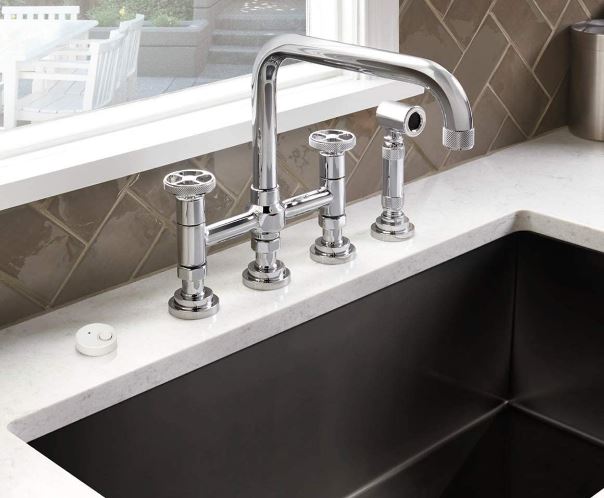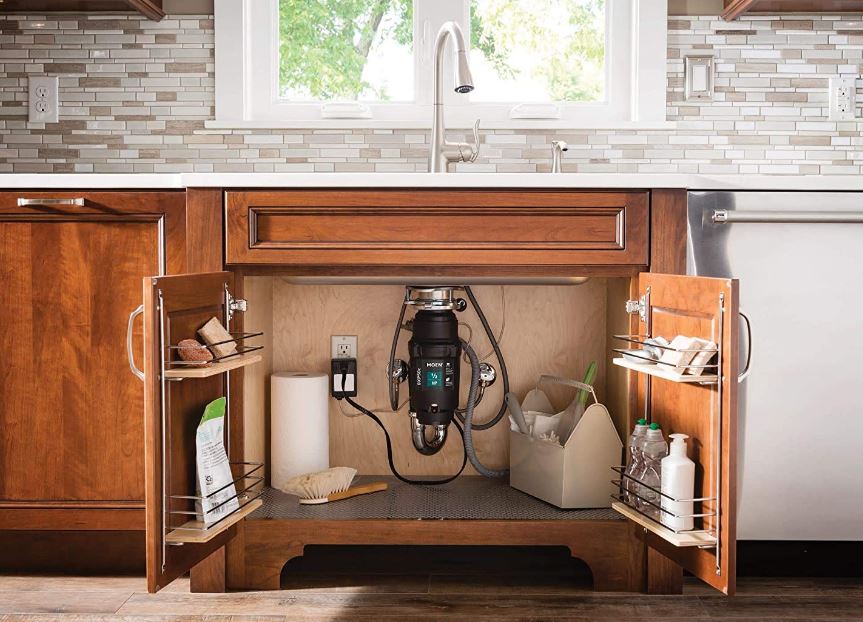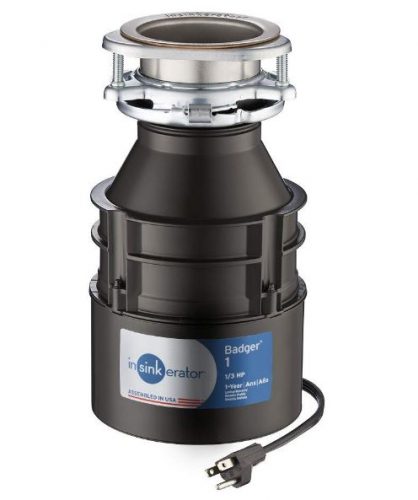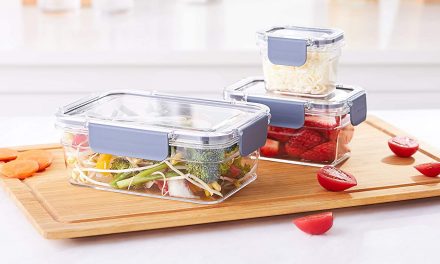Garbage disposals speed up rinsing and washing dishes by allowing you to grind up food waste as you clean. Putting food waste down your sink takes it away from landfills and decreases the size of food particles that water treatment systems have to filter and process. Some municipal water systems even use this shredded food to generate energy now! But not all garbage disposal systems are the same. Some are better for certain households than others.
In this article we’ll talk about the different types of garbage disposals available on the market, how their motors and switches work, and what types are most likely to suit your needs.
Types of garbage disposals by size and power
Garbage disposals are mostly categorized by their power, specifically their horsepower (HP). There are four different motor categories, ranging from 1/3 HP, up to 1 HP. The less horsepower, the weaker and cheaper the disposal. More horsepower means stronger and more expensive.
In general, disposals with weaker motors will also be smaller and have less grind chamber capacity, but this isn’t always the case, so check closely if the size of the unit matters. Most disposals, regardless of motor power, have a grind capacity between 26 and 40 ounces. Similarly, most disposals are 11-15 inches tall, 5-9 inches wide, and 6-13 inches deep.
Motor power is what you should focus on most. Don’t get caught up in grinding speed specs (blade rotations per minute). Regardless of motor, most garbage disposals have grinding speeds between 1725-2800 RPM. What matters is if the motor is powerful enough to use that grinding speed to cut up difficult material without jamming.
Unless you’re living alone and rarely use a garbage disposal, you should probably consider the slightly larger and more powerful disposals on the market—that is, those with a 3/4 or 1+ HP motor.
- 1/3 HP motors are the weakest of the garbage disposal motors, but they’re good for anyone who doesn’t plan on using their garbage disposal often. They’re also a good fit for vacation homes that don’t see much use. As the weakest motors, these are found in the cheapest garbage disposals, costing between $50 and $130.
- 1/2 HP motors are still fairly weak but can support a small household with a couple of people, provided plenty of water is run through them during or between uses. In general, expect to pay between $60 and $160 for these garbage disposals.
- 3/4 HP motors are powerful enough for most households, including those with several people in them. They’re also more likely to have stainless steel components instead of plastic, giving them a longer life expectancy. The one minor disadvantage to these disposals is they aren’t powerful enough to cut through especially though materials, like bone. Expect to pay $90-$280 for a 3/4 HP motor.
- 1+ HP motors can grind through just about anything you put in them, from small bones, to thick rinds and meat, and they’re very unlikely to jam. These powerful motors are good for larger households that use the disposal regularly during cleanup. Expect to pay for the power, though. These garbage disposals tend to cost between $200 and $410.
Types of garbage disposals
Garbage disposals are basically big, powerful food processors connected to your sink, so maybe it’s no surprise that the two main types of food processor—continuous feed and batch feed—are also the two types of garbage disposal. That’s where the similarities start and end between these kitchen devices, however, as the use and application of a garbage disposal is so different.
Continuous feed
The vast majority of garbage disposals available on the market are continuous feed models. As the name implies, these are garbage disposals you can continuously add food waste to while you’re cleaning. Simply flip the wall switch to activate the motor and you’re good to go. For best results, run cool water through the system the entire time you’re using it.
What are the pros and cons of continuous feed garbage disposals?
There’s a reason continuous feed disposals are so common: they’re exactly what most households need. Easier to use than batch feed disposals, they also happen to be cheaper and are far more likely to have advanced features that prevent jams (sometimes called “auto-reverse” features). That said, they may not be appropriate for households with children or disabled family members who may be more prone to accidents and injury when around the disposal.
Pros
- Easier to use; simple on/off switch functionality
- Less expensive than batch feed disposals
- More likely to have advanced features that prevent jams
Cons
- Less safe for households with children or intellectually disabled family members
Price range: $50-$130
Batch feed
As with “batch bowl” food processors, batch feed garbage disposals grind food up in batches. In the case of the garbage disposal, the batch isn’t limited by a bowl, but rather by the need to place a cover (stopper) over the drain for the motor to be operated. Literally, you have to feed them in batches.
This makes them far less convenient, on par with simply scraping food scraps into a garbage can, which is why they’re not as common (and why they’re more expensive). But they are ideal for households with small children or the intellectually disabled. No one is able to put their hands or other items in these garbage disposals and operate them at the same time.
Pros
- Safer for households with children
Cons
- Less convenient for households without children
- More expensive than continuous feed disposals
Price range: $230-$280
Types of garbage disposal switches
When it comes to operating your garbage disposal, you have a couple of switch options if your home isn’t already hardwired for a garbage disposal wall switch.
Air switches
Garbage disposal air switches are nothing more than a simple operating button that can be installed into a countertop or sink rim. When this button is pressed, air pushes through an airtight hose that’s connected to the garbage disposal’s power controls, thus activating the disposal by way of air.

See Cleesink’s garbage disposal air switch kit. Note the button to the right of the faucet.
Because of their close proximity to the sink, air switches are extremely convenient and are often designed in a way that will complement sink styles. They’re also very safe, as any parts you interact with don’t come into direct contact with electrical components. Major downside? Installation may not be so simple. Unless you have a space faucet hole available, you may need to drill a hole in your counter or sink.
Depending on what comes with an air switch kit, you can expect to spend $20-$50, on average.
Wireless switches
Looking for the latest and greatest way to control your garbage disposal? Consider a wireless switch. Wireless switches have the same safe push-button concept that air switches have, but instead of making use of a mechanical piece, like an air hose, they trigger a garbage disposal’s power at the source.
The disposal’s power cord is plugged into an adapter, which is then plugged into the power supply beneath the sink. When you push the disposal button, it sends a signal to the adapter, which then functions as an intermediary between the power supply and the disposal.

See Cleesink’s self-powered remote switch for garbage disposals. Note the easily removable, above-counter button placed to the left of the faucet.
While wireless switches may not blend as seamlessly into your kitchen’s design, they are easier to install than air switches—really, as simple as plugging something in. Some models, like Didikit’s, even come with timers that will operate the disposal for exactly 30 or 60 seconds at a time.
Wireless switch kits usually cost $20-$30.
Hardwired disposals
Traditionally, and to this day, many garbage disposals are hardwired into a kitchen’s electrical wiring. This is the case whenever you see a disposal that operates by way of a nearby wall switch.
If your home has already been wired with a garbage disposal in mind, there’s really no reason to opt for a different disposal switch. On the flip side, if your home hasn’t been wired for a garbage disposal or disposal switch, this isn’t a DIY project you should take on, as it may involve electrical work.
Other garbage disposal features to consider
After you’ve decided on the type of garbage disposal, motor size, and switch you want, a lot of pricing comes down to the finer details of individual features.
Which garbage disposal is quietest?
There’s no denying a garbage disposal sounds like a little disgruntled chainsaw in your sink drain. Unfortunately, there’s no standard for rating the volume of garbage disposals in action, so manufacturer’s claims about volume levels are dubious at best. Still, there are a few things you can look for or do to cut down on a garbage disposal’s noise.
- Get a more powerful motor. A more powerful motor is one you won’t have to run as long to get the job done. Weaker motors will take longer, and you may hear them struggle loudly through the grinding process.
- Go for larger units. More powerful motors are usually found in larger disposals, but you should still pay attention to the dimensions of a disposal before purchase. The larger the disposal is, the more likely it is to use at least some of its size to dampen noise.
- Look for nylon-coated blades. These coated blades will wick away substances more easily, clearing them from the blades faster.
- Also look for flexible mounting and good baffling. Disposals are mounted to sink drains with a series of gaskets, flanges, and rings. Some manufacturers design disposals with more flexible connections that wiggle while the disposal is in use. This cuts back on vibration and therefore noise. Similarly, some disposals come with additional baffling (soundproofing panels) that dampen sound.
What makes some garbage disposals more expensive than others?
Three things set more expensive garbage disposals apart from cheaper ones: part materials, grind stages, and anti-jamming features.
Cheaper garbage disposals rely on more plastic connections than expensive models, which tend to use stainless steel parts that are more likely to last longer. This may seem like a big deal, but really a lot depends on use and motor power.
Grind stages and anti-jamming features are the more noticeable differences between price points. Cheaper garbage disposal models almost always have a single grind stage, and they lack anti-jamming technology. Food passes through grinding blades which chop it into fine grounds before sending them on through the pipes. If the blades jam badly, you may need to turn off the disposal and manually clear them.
More expensive garbage disposals actually have multiple sets of blades, allowing for finer grounds, almost to the point of liquefaction. This is useful if you have pipes that are prone to clogging. Typically disposals aren’t recommended for such pipes, but more expensive disposals with multiple grind stages can get around this problem.
With such extreme grinding, you’re unlikely to face jams, but if you do, many expensive models also come with an auto-reverse feature that detects jams and reverses the spin direction of the blades, thus loosening the jam to get on with grinding.
Top garbage disposal brands
While there are numerous manufacturers making garbage disposals, a few stand out for their large product lines and well-established presence in the disposal and/or kitchen sink industry.
- InSinkErator, a subsidiary of Emerson Electric, is who you can thank for the whole idea of the garbage disposal. They’ve been inventing, designing, and assembling garbage disposals in the United States since 1927 and remain an industry leader for a reason.
- As a manufacturer of faucets and sinks, it’s perhaps no surprise that Moen has branched out into garbage disposal manufacturing. With disposals manufactured in China, they tend to be more affordable than InSinkErator disposals, but more expensive than Waste King disposals, typically due to their additional features.
- Like the InSinkErator brand, Waste King has been around for well over 50 years. Their disposals are made in China and tend to be more affordable than those manufactured by the brands above.
Garbage disposal use and maintenance
You can probably expect your garbage disposal to last about 10-12 years, though their lifespan improves if you use them smartly.
If you want your disposal to last for a long time, clear it with cool water only, don’t subject it to fibrous or greasy foods too often, and rinse it after exposure to acidic foods. To deodorize it, grind citrus peels and then rinse. Want to keep the blades nice and sharp? Run a glassful of ice through the disposal every three to six months.
As for jamming, it shouldn’t happen often, if at all, when you have the right motor for the tasks you’re giving your disposal. In the event that a jam does occur, more expensive disposals will have an anti-jamming technology that will react to a jam. Meanwhile, less expensive models may come with an allen wrench that will let you get under the sink and disposal to dislodge the jam manually.
DIY garbage disposal installation
The installation of a garbage disposal is a great DIY project, as most only take 2-4 hours to install. When you’re buying a disposal you plan to install yourself, keep the following things in mind.
- Unless you’re living alone and don’t plan to use your disposal for much, you should buy a garbage disposal with a 3/4 HP motor or better. It’ll handle most anything you put in it, and it’s more likely to be quiet, or at least to operate more quickly.
- Look for “quick mount” or “EZ mount” disposals. These disposals are designed with the DIYer in mind. Installation is far easier with these, often just a matter of turning the device until it locks into place. One of the most highly-rated EZ mount disposals is Waste King’s 3/4 HP garbage disposal.
- Watch for power cords. If you need a power cord for your disposal, note that not all disposals come with one by default. At roughly $10-$20, a power cord isn’t a huge expense, but it can be a hidden one. If you’re installing a disposal from scratch, look for one that comes with a cord. If you’re replacing an old disposal, see if you can’t use the old cord with your new disposal if it doesn’t come with one.
- If your kitchen isn’t hardwired for a garbage disposal, get a wireless switch unless you’re confident enough to install an air switch.
Check out this video to learn how to remove an old garbage disposal and replace it with a new one!





